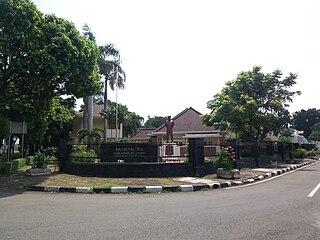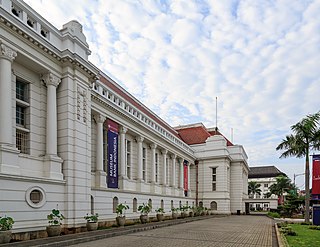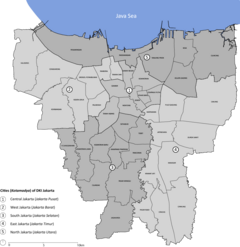
Pasar Minggu is a district in the administrative city of South Jakarta, Indonesia. The area is known for its traditional Sunday market, famous for the fruit market. Historically, Pasar Minggu is a fruit cultivation area developed by the Dutch government during the colonial period. The central point of the cultivation area is the traditional market of Pasar Minggu, located in what is now the lower-division Pasar Minggu subdistrict. Teak forest could also be found in the Pasar Minggu district, notably around the Jati Padang subdistrict. Most of these areas have been converted into residential areas as Jakarta grows southward.
Grogol is an urban administrative village in the Grogol Petamburan subdistrict of West Jakarta, Indonesia. The triangle-shaped administrative village is bounded by the West Flood Canal to the east, Jakarta Inner Ring Road to the west, and Jalan Kyai Tapa to the south. It was among the first Jakarta's planned suburb established during the 1960s.

The Sasmita Loka Ahmad Yani Museum houses a collection from Ahmad Yani and some dioramas about the G-30-S/PKI, 30 September 1965. The museum is located in jalan Lembang 58 or jalan Laturharhari 65, Central Jakarta, Indonesia. The museum is open free to public from Tuesday until Sunday, from 08:00 WIB until 14:00 WIB.

Gereja Sion is a historic church located in Pinangsia Administrative District, Taman Sari, Jakarta, Indonesia. Dating from 1695, it is the oldest church still standing in Jakarta.
Roa Malaka is administrative village at Tambora subdistrict, West Jakarta, Indonesia. The border of Roa Malaka are :

Colonial buildings and structures in Jakarta include those that were constructed during the Dutch colonial period of Indonesia. The period succeeded the earlier period when Jakarta, governed by the Sultanate of Banten, were completely eradicated and replaced with a walled city of Batavia. The dominant styles of the colonial period can be divided into three periods: the Dutch Golden Age, the transitional style period, and Dutch modernism. Dutch colonial architecture in Jakarta is apparent in buildings such as houses or villas, churches, civic buildings, and offices, mostly concentrated in the administrative city of Central Jakarta and West Jakarta.

The Jakarta Art Building, historically known as Schouwburg Weltevreden, is a concert hall in Sawah Besar, Central Jakarta, Indonesia, built during the colonial period in Batavia, Dutch East Indies.

Mandiri Museum, or Bank Mandiri Museum, is the corporate museum of the namesake Bank Mandiri, located in the old banking district of Jakarta Old Town in northern Jakarta, Indonesia. The museum is housed in the former headquarters of the Netherlands Trading Society, one of the primary ancestor of ABN AMRO. The museum is closed on Mondays and public holidays. It is located next to Museum Bank Indonesia, and right in front of Jakarta Kota Station.

The Citadel Prins Frederik, also called Fort Prins Frederik, was a fortification built in 1837 by the Dutch in Batavia, in the Dutch East Indies. It was located at Wilhelmina Park, which demolished around 1961 and replaced by the Istiqlal Mosque.

Pieter Adriaan Jacobus "Piet" Moojen was a Netherlands-Indies architect, painter and writer. He studied architecture and painting in Antwerp. He lived and worked in the Dutch East Indies from 1903 to 1929. He was one of the first architects to implement Modernism in the Dutch East Indies. Moojen became widely known for his work on the Dutch entry at the Paris Colonial Exposition in 1931. He was active as an architect between 1909 and 1931.
Tugu Church, is a Protestant church in Kampung Kurus, Semper Barat Administrative Village, Cilincing, Jakarta, Indonesia. The church was located in Kampung Tugu, a village of Mardijker people, a Creole Portuguese community. It is the second oldest church in Jakarta, after Sion Church

Bank Indonesia Museum, also called in English officially as BI Museum, is a bank museum located in Jakarta, Indonesia. It was founded by Bank Indonesia and opened on 21 July 2009. The museum is housed in a heritage building in Jakarta Old Town that had been the first headquarters of the Netherlands Indies gulden, the central bank of the Dutch East Indies. The bank was nationalized as Bank Indonesia in 1953, after Indonesia gained its independence. It is located next to Mandiri Museum.

Gedung Antara is a Dutch colonial landmark in Jakarta. It is located in the vicinity of Pasar Baru area. The building is currently Antara's Institute of Journalism.

Waterkasteel was the northernmost defense of Batavia, Dutch East Indies. It was located on the west end of the Sunda Kelapa pier. Because of its location, the fort was also known as "Hornwerk".

Batavia Castle was a fort located at the mouth of Ciliwung River in Jakarta. Batavia Castle was the administrative center of Dutch East India Company (VOC) in Asia.

Hotel der Nederlanden was a historic hotel in Jakarta, Indonesia. Hotel der Nederlanden was one of the three grand hotels in Batavia during the last period of the colonial rule, the other being Hotel des Indes and the Grand Hotel Java. The hotel had operated for more than a century, after which it was demolished in 1969 and was replaced with the Bina Graha presidential office.

Al-Azhar Great Mosque is a mosque located in Jalan Sisingamangaraja, Kebayoran Baru, Jakarta. The mosque was constructed between 1953 and 1958. It was originally known simply as Mesjid Agung. It was Jakarta's largest mosque when it was built until it was surpassed by the Istiqlal Mosque, which was completed in 1978. Al-Azhar mosque and its complex are best known for their educational works.

Kim Tek Ie Temple, also called Vihara Dharma Bhakti, also known as 金德院, is a klenteng located in the China Town neighborhood of Glodok, Jakarta, Indonesia. Completed in 1650, Vihara Dharma Bhakti is the oldest Chinese temple in Jakarta.

The A.A. Maramis Building is an early 19th-century building in Jakarta, Indonesia. It hosts the headquarters of the Indonesian Ministry of Finance.

G. Kolff & Co., was a firm specializing in bookselling, publishing and printing based in Batavia.




















